I would like to look at family records
MyHeritage Releases a Significant Collection of Lithuanian-Jewish Historical Records
- By Talya
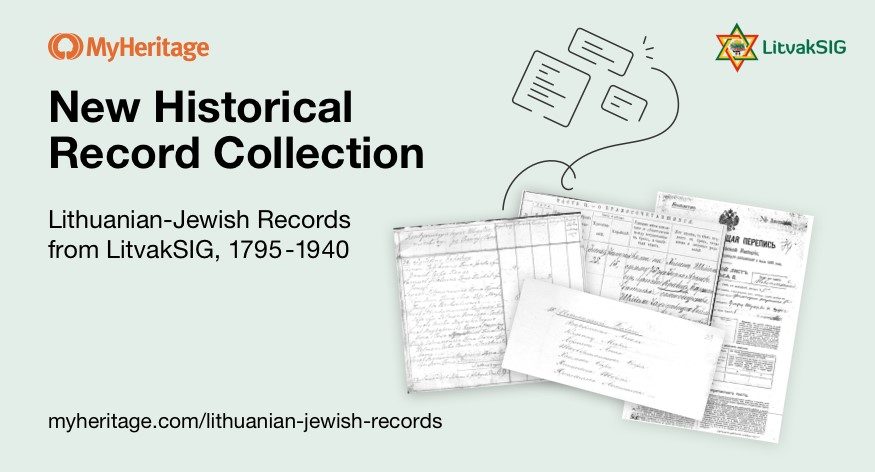

We are pleased to announce the publication of an important collection with several million Jewish historical records from Lithuania, dating from 1795 to 1940. The records are being released in coordination with LitvakSIG.
LitvakSIG is a U.S. non-profit organization that provides the primary online resource for Lithuanian-Jewish genealogy research worldwide, and MyHeritage is a big fan of this organization and the important work it is doing. The records in this collection were originally translated and indexed by LitvakSIG, and represent almost the entire corpus of LitvakSIG’s work over more than twenty years. These records have now been added to MyHeritage’s historical record database.
The records are of several different types: revision lists, vital records, tax & voter lists, and household registers and other records pertaining to the Lithuanian-Jewish (Litvak) population from the period of the Russian Empire (1795–First World War) to the period of independent Lithuania (1919–1940). Most of these records cannot be found on other commercial genealogy websites. Together with MyHeritage’s advanced search and matching technologies — which overcome language barriers and provide matches to family trees in English, Russian, and Hebrew among other languages — these records will open a new frontier of discovery for individuals who are researching their Lithuanian-Jewish heritage.
The records contain the names of several family members in addition to the primary person, such as the father, mother, spouse, paternal grandfather, and maternal grandfather. Most records contain the date and place of the pertinent event, and may include a secondary event such as the year or place of birth. The majority of records are from cities in present-day Lithuania. However, due to various geopolitical changes during the time period of this collection, the records are not limited to the modern boundaries of Lithuania, and the places listed in records may also be located in present-day Poland, Belarus, or other neighboring countries.
Here are some more details about the records found within this collection:
Revision list collections
Revision lists (first half of the 19th century) and family lists (second half of the 19th century) form the largest part of this collection. They were created in the Russian Empire as the basis for taxation and military conscription. They included essentially all Jewish residents, since very few Jewish people were educated enough or wealthy enough to merit an exemption. These lists are very similar to a modern census: they list all members of a household and their relationships, as well as other information such as their age and place of birth.
Another large piece of this collection consists of military conscription lists. In many cases, the lists included not just the conscript, but also family members.
Vital records collections (birth, death, marriage, and divorce):
Vital records in the Russian Empire were maintained separately for each religion. However, for the part of Lithuania that was formerly part of East Prussia (Klaipeda district), all vital records were recorded together. In that case, the religion of each event was part of the record. These collections are very similar to modern vital records and contain important details about life events. You may be able to find given and surname information, birth date and birth place information, birth dates and places of birth, marriage and divorce dates, names of spouses and family members, and in the case of death certificates, death dates and burial information.
Tax and voter collections:
There were several types of tax and voter lists that related to the Jewish community in Lithuania during this period.
Taxes
Taxes were collected for purchases on kosher meat, Sabbath candles, and real estate. Tax Lists generally list the family name, first name, and father’s name of all heads of households in the community. Sometimes the wife’s name, the number of family members (or number of male members of the household), occupation, and financial status or class is also included. Many indicate the ages and dates of death. Some indicate profession or are specifically compiled based on profession like Merchant Lists or Craftsmen and Guild Lists.
Jews in Lithuania were taxed for a variety of items, and records were kept on who incurred the tax. These taxes included a ”box tax” — a tax on kosher meat, a candle tax on Sabbath candles, and real estate taxes.
Merchant Lists
These are lists of the merchants (of 1st, 2nd and 3rd classes) who were permitted to trade in a district and may include the entire family. Merchants were often not listed in general family lists or other taxpayer lists, so these can be very valuable records.
Craftsmen Lists
Both craftsmen and artisans belonged to guilds and were given special privileges, including exemption from some taxes. Families often followed the same craft trades from one generation to the next, making these lists very useful in genealogical research. There are records of craftsmen for the second half of the 19th century, but the lists are often incomplete.
Voter Lists
Voter lists consist of lists of eligible voters for various state, local, and religious government authorities.
Sample Records
Marriage record of Lev Garfinkel
Lev Garfinkel (1986–1976) was the editor of a Yiddish daily newspaper which was published in Kovno (Kaunas). He was arrested and tortured in April 1944 under charge of engaging in “underground activity,” and after the Kovno Ghetto was liquidated, he was sent to the Kaufering concentration camp. He managed to survive the war and the Holocaust.
The collection contains a record of his marriage to Dora Rabinovich in 1936 and is very detailed. The record lists Dora’s parents’ names, Izrael and Chaja; as well as details about where they got married, Taurage, Lithuania; the names of the Rabbi and witnesses, and Lev’s profession is listed as lawyer.
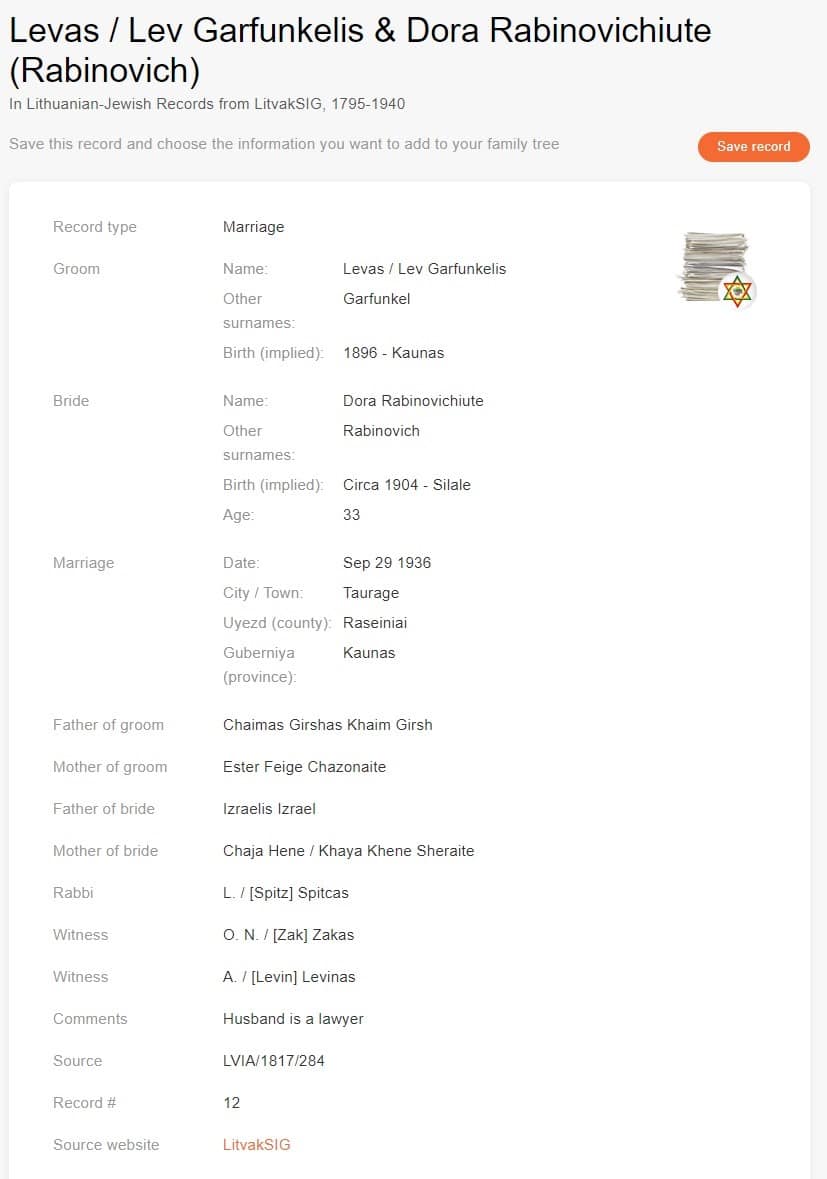
Exile record of Leah Goldberg’s mother
Leah Goldberg (1911–1970) is among the most celebrated Hebrew-language poets, authors, and playwrights. She was born in Konigsberg (now Kaliningrad), Prussia, in 1911, and spent her childhood in Kovno, Lithuania. During World War I, her family was exiled to Russia.
The collection contains a record of the exile of Leah’s mother, Tsila, from 1915 and her return to Siauliai, in the Kaunas region, in 1921.
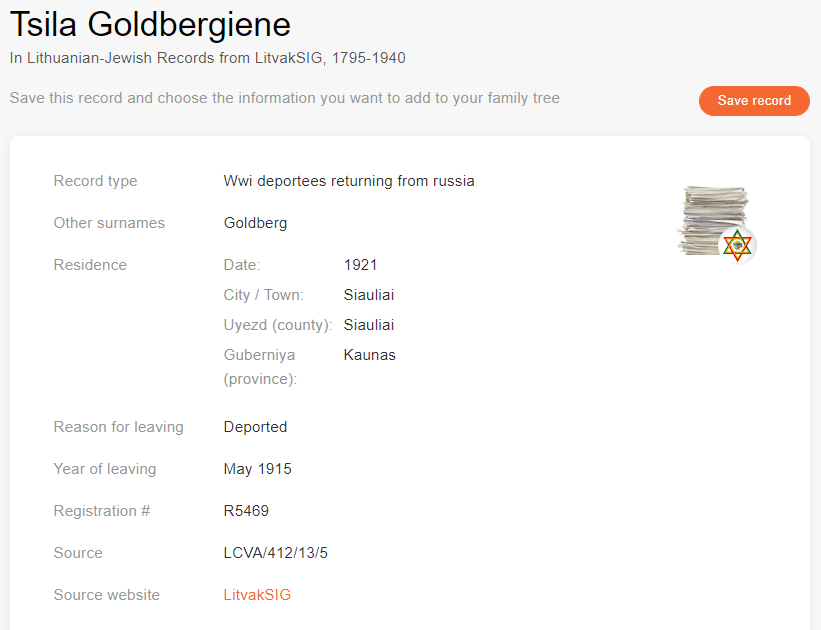
Leah and her mother moved to Tel Aviv in 1935.
Summary
We are proud to offer our users this new and important compilation, as part of our efforts to expand the resources available on MyHeritage for users of Jewish heritage. This collection, Lithuanian-Jewish Records from LitvakSIG, 1795–1940, offers rich insights into the lives of Lithuanian Jews during a pivotal period in this group’s history. Searching the collection on MyHeritage is free. To view these records or to save records to your family tree, you’ll need a Data or Complete plan. If you have a family tree on MyHeritage, our Record Matching technology will notify you automatically if records from the collection match your relatives.
Do you have Lithuanian heritage? Be sure to check out Lithuanian surnames on the MyHeritage Wiki.
We also would like to put in a good word for LitvakSIG and call upon anyone who has Jewish-Lithuanian roots to consider supporting them.






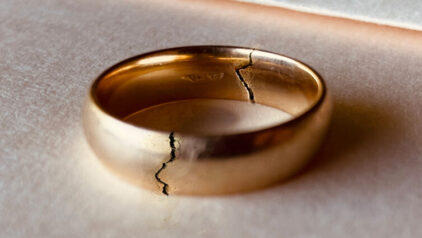


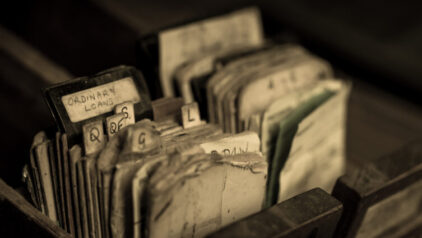
elie hayon
April 7, 2021
Want to know the early history of my ancestors from Vilna from the 1780’s onwards.
The family is Rosenthal and came to Israel from 1780 onwards.They were the MUCHTAR of Jerusalem for well over a century.
Many thanks.